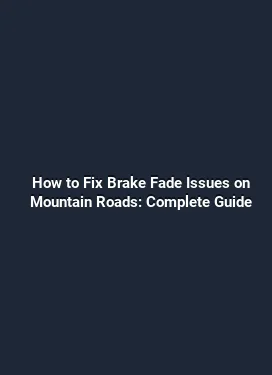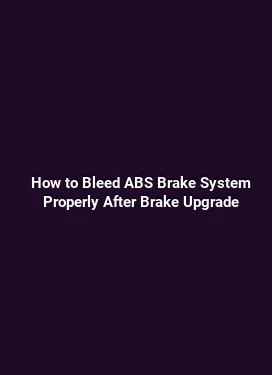How to Install Brake Duct Hoses for Track Day Cooling Setup
Efficient cooling is a cornerstone of reliable braking performance on track days. Brake duct hoses channel ambient air toward the brake components, reducing heat buildup during high-speed laps and aggressive deceleration. This guide explores a comprehensive approach to selecting, routing, mounting, and maintaining brake duct hoses to maximize cooling efficiency without compromising suspension geometry or aerodynamics.
Makale içindeki ilk H2 başlık buraya gelmeli

Track surfaces differ dramatically across events, temperatures, and driving styles. A well-designed brake duct system addresses three core objectives: delivering sufficient volumetric airflow to brake rotors and calipers, maintaining consistent duct pressure to avoid heat soak, and minimizing parasitic drag that could affect vehicle balance. Understanding these goals sets the foundation for selecting hoses, fittings, and mounting hardware that endure the rigors of track use.
Makale içindeki ilk H3 başlık buraya gelmeli

Brake ducts rely on a simple airflow principle: air travels from the outside of the vehicle into ducts that route toward critical braking components. The challenge is to maintain a steady flow under dynamic track conditions, where vehicle pitch, wheel travel, and suspension movement can influence duct alignment. The following sections examine materials, routing strategies, and installation steps that translate theory into durable, real-world performance.
Understanding the Cooling Demands on Track Days
Brake systems generate significant heat during repeated hard braking, especially on moderate-to-long straightaways where brake cooling is insufficient. Heat can lead to pad glaze, rotor warping, and reduced friction efficiency. High-quality duct hoses help manage this heat by providing a controlled path for ambient air to flow directly to the rotors, calipers, and, where applicable, the backing plates. Several factors influence cooling effectiveness: rotor size, caliper design, wheel and fender clearance, and the track’s typical temperature range. A well-tuned ducting solution mitigates fade and extends the life of consumables, enabling more consistent lap times and safer operation at the limit.
Design considerations for effective ducting
Key design considerations include hose diameter, material resilience, internal smoothness to minimize turbulence, and compatibility with mounting points. Larger diameter hoses can deliver more air but may require careful routing to avoid interference with suspension arms, steering components, or tire contact. Internal coatings or smooth interiors reduce boundary layer effects, helping maintain laminar-like flow through bends. Materials should resist heat aging and UV exposure while remaining flexible enough to accommodate chassis movement without cracking or kinking.
Choosing the Right Hoses and Materials
Brake duct hoses come in various materials, including reinforced rubber, silicone, and heat-resistant plastics. Each option presents a balance between pliability, heat resistance, and durability. For track use, selecting hoses with reinforced walls and sufficient temperature resistance is essential. Silicone ducts, for example, offer excellent heat resistance and flexibility, while reinforced rubber hoses can provide robust abrasion resistance in tight engine bays. Consider the environment: proximity to hot exhaust routing or turbochargers may demand higher temperature ratings and insulation.
In addition to hoses, the assembly requires compatible connectors, clamps, and mounting hardware. Stainless steel or high-grade aluminum clamps resist corrosion and maintain consistent clamping force under vibration. Quick-release or locking clamps may simplify maintenance but should be evaluated for reliability under track conditions. It is important to ensure that connector ends have smooth interior surfaces to minimize flow disruptions and reduce the risk of hose collapse at high speeds.
Material compatibility and durability considerations
When selecting hose materials, assess their resistance to oil, fuel vapors, and automotive fluids that could contact the ducting during a track day. Moisture and debris entering the ducts can impair airflow and create imbalanced cooling. A protective outer layer or shield can protect hoses from road debris and wheel spray, especially on cars with large brake discs exposed to the airflow.
Preparing Your Vehicle for Hose Installation
Before installing duct hoses, perform a thorough inspection of the braking system and surrounding components. Check rotor and caliper clearances, wheel well geometry, and the availability of solid mounting points for ducts. Identify potential interference areas with brake lines, suspension arms, or steering knuckles. Measuring the available space behind the brake rotor is critical to determine the maximum allowable hose length and diameter, ensuring that hoses do not contact moving parts or the tire during compression and rebound.
Next, verify alignment for optimal air intake. Even a slight misalignment can reduce cooling efficiency, so plan hose routing that avoids sharp bends while maintaining a direct path to the rotor or caliper face. Document the planned layout with photos or sketches for reference during installation. A clean, organized workspace and labeled components help reduce installation time and error margins.
Safety considerations and torque guidelines
Use caution when working near hot brake components. Allow ample cooling time before handling rotors and calipers, and wear appropriate PPE. Use torque specifications from the vehicle’s manual or manufacturer recommendations for any mounting points on duct hardware. Over-tightening clamps can damage hoses, while under-tightening can cause air leakage and reduced effectiveness. When in doubt, test fit the assembly first to confirm clearance and fitment before finalizing the installation.
Routing and Securing Duct Hoses
Routing is a critical step because it directly impacts airflow efficiency and reliability during a race or track day. A well-routed duct system minimizes turbulence, reduces the chance of hose collapse, and prevents contact with rotating assemblies. Begin by planning a path from the intake in the wheel arch or front bumper area to the rotor or caliper housing. Use a combination of brackets, ties, and dedicated ducts to hold hoses in place without restricting wheel travel or steering movement.
When routing, avoid placing hoses in areas subjected to high heat or potential contact with hot exhaust components. If necessary, wrap hoses with heat-resistant sleeves or shields to protect against radiant heat and abrasive wear from tire debris. Ensure that all hoses remain off the ground plane to prevent damage from road obstacles and debris on street-driven test days or during in-between sessions.
Securing methods and mounting strategies
Secure duct hoses with clamps that provide consistent gripping force without crushing the hose wall. Consider using vibration-damping mounts or rubber brackets to absorb engine bay or wheel well vibrations. If space is limited, one or two strategically placed supports can keep the hose away from moving parts while maintaining a clean, low-profile setup. For cars with removable fenders or easily accessible wheel wells, check for easy removal of the ducts for maintenance between sessions or events.
Connecting Ducts to Brake Components
Connection points should direct air toward the rotor’s edge or the caliper body, depending on the design. The goal is to maximize the clean, cool air reaching the braking surface without creating a high-velocity jet that escapes without benefiting the rotor. A common approach is to position the hose outlet just upstream of the rotor hat or behind a solid backing plate so that air shafts through the rotor gap and helps reduce surface temperatures.
For systems using multiple ducts, balance airflow between the left and right sides to prevent asymmetric cooling. Unequal cooling can induce brake bias changes during heavy braking and cornering, potentially altering the vehicle’s handling characteristics under braking load. Regular checks during maintenance should confirm that hoses remain properly aligned and that there is no significant airflow discrepancy between sides.
Sealing and leak prevention
Seal every junction with appropriate gaskets or O-rings if the duct system uses interlocking components. Air leaks at joints significantly reduce cooling efficiency, especially at higher speeds where the airflow is pressurized. Verify the integrity of each connection with a quick air pressure test using a low-velocity air source before a test session. A small amount of leak testing during installation helps catch issues that might otherwise only appear after heat cycling on track days.
Maintenance and Inspection After Track Sessions
Post-session inspection is essential to ensure long-term reliability. Look for signs of wear at bend points, clamps, and mounting brackets. Heat cycling can cause hoses to become rigid and crack over time, especially in areas with repeated bending. Inspect for discoloration, surface cracking, or softened spots along the hose length. Replace any hoses showing visible damage, and re-tighten clamps if they have loosened after vibration. Cleaning dust and debris from the ducts helps maintain consistent airflow and reduces the risk of clogging or micro-abrasion on the hose interior.
Record mileage, session data, and any observed cooling performance changes. If brake temperatures rise more quickly than expected or rotor temperatures show wider variations across sessions, re-evaluate hose routing, check for leaks, and consider upgrading to hoses with higher temperature ratings or improved interior smoothness. Routine inspection and timely replacement are essential parts of a robust track day cooling strategy.
Practical Tips and Common Pitfalls
Several practical tips can save time and improve cooling performance. First, pre-fit hoses off the vehicle to verify fitment and clearance before final assembly. Second, keep hose lengths as short as reasonably possible to minimize resistance while avoiding tight bends that restrict airflow or cause kinking. Third, consider aerodynamic implications; extending ducts slightly outward from the wheel well can encourage a more direct air path while avoiding drag penalties that are more noticeable at higher speeds. Finally, maintain a clean engine bay and wheel well environment; reduced dirt and debris lead to fewer restrictions within the duct system and less wear on hose interiors.
Track testing provides valuable feedback. Start with a conservative setup, gradually increasing duct diameter or routing adjustments to observe changes in rotor temperatures and pad performance. Logged data, including brake temperatures at various track sections, helps tailor the ducting system to the specific demands of the track and driving style. A modular approach—with swap-ready hose lengths and mounting points—allows quick iterations between sessions or events.
Long-Term Considerations for Performance-Oriented Builds
For enthusiasts pursuing consistent track performance, consider upgrading to high-heat-rated hoses with reinforced walls and reflective or light-absorbing coatings to minimize radiant heat absorption. Advanced installations may benefit from adding flow-directing features such as shields or deflectors that bend the air toward the rotor face instead of washing over the rotor edge. When upgrading, ensure compatibility with wheel sizes, brake rotor dimensions, and caliper geometry to prevent interference with other components. Periodic testing and data logging remain critical to validating improvements and guiding future adjustments.
In summary, a well-planned brake duct hose installation supports robust cooling, reduces the risk of brake fade, and sustains consistent braking performance across sessions. By paying attention to material choice, routing, mounting, and maintenance, you can build a reliable cooling solution that complements the overall braking system and vehicle dynamics on track days.






